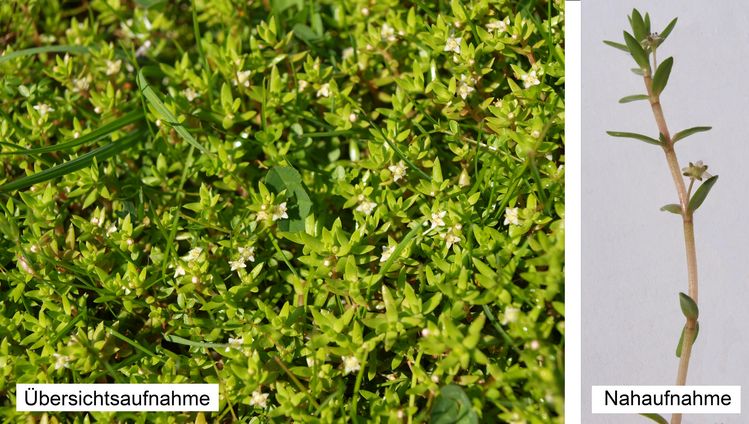Info page Crassula helmsii (New Zealand pigmyweed)
What does the Crassula helmsii look like?
Crassula helmsii is an ornamental evergreen plant up to 15 cm tall. The leaves are narrow, lanceolate and cross-opposite, i.e. there are always two leaves opposite each other and the next pair of leaves is offset by 90°. The stem is round and has little or no branching. The pairs of leaves are fused together at the base and new roots can also be formed at the base of each pair of leaves. The stalked flowers emerge from the leaf axil and have four white petals. The flowering period is from August to September. Each flower can produce 2-5 seeds, which are brown, oval and quite inconspicuous with a size of 0.5 mm.
Where does the Crassula helmsii originally come from? Where is it found?
Originally from New Zealand, the plant was imported to Europe at the beginning of the 20th century. Crassula helmsii is used in horticulture and aquaristics, where it can also be purchased under the synonyms Tillaea helmsii, Bullardia recurva or Crassula recurva. In some countries of the European Union, including Great Britain, trade in Crassula helmsii is prohibited. Crassula helmsii has been spreading there since the 1970s and is now a huge ecological problem. It can also be found in ten other countries in the European Union, the United States of America and Russia.
In Germany, Crassula helmsii was first sighted in the wild in the Palatinate Forest in 1981. Since the early 2000s, it has been found on Norderney in the south beach polder and on the Meierei meadows. In October 2017, an occurrence was confirmed on the island of Wangerooge.
Crassula helmsii can be found on the edges of waterways and in bodies of water. It tends to be found in shallow and unshaded places in still and flowing waters. Freshwater locations are favoured, but the species can also be found in brackish water locations on Norderney.
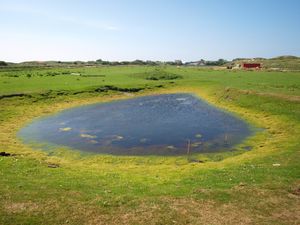 | 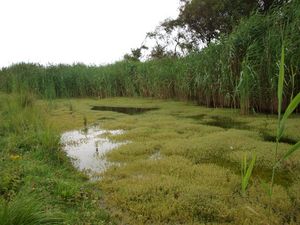 |
|---|---|
| Meadows | South beach polders |
In its native habitats on New Zealand's South Island, Crassula helmsii can be found on rocky coasts and beaches as well as in shallow waters, gravel banks or damp places in the lowlands. These locations are usually shady and always close to fresh water.
How does Crassula helmsii spread?
Crassula helmsii spreads via tiny plant fragments from which a complete new plant can grow. These fragments are transported to new locations via the fur of wild animals, the plumage of birds or through movement in water. New plants can also be formed from root fragments. In addition, Crassula helmsii has a high seed production of up to 70,000 seeds per square metre. The seeds can also reach new locations via the above-mentioned methods.
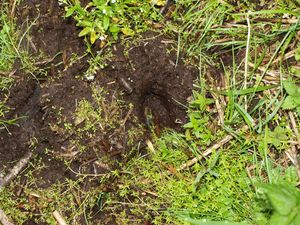 | 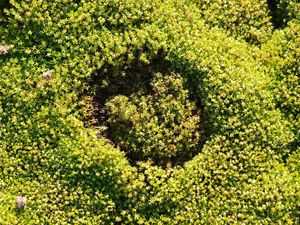 |
|---|---|
| Footprints of wild animals | Footprint of a horse |
How does the Crassula helmsii affect its environment? What does this mean for nature conservation?
Crassula helmsii has been shown to jeopardise biodiversity, not only for other plants, but also for amphibians, invertebrates and birds. Crassula helmsii also grows rapidly and forms areas where few or no other plant species are found. These partially floating lawns result in the loss of existing structures and thus the habitat of animals and plants. In its nature conservation invasiveness assessment, the Federal Agency for Nature Conservation came to the conclusion that Crassula helmsii should be categorised as an "invasive species".
As a result of this categorisation, Crassula helmsii has been blacklisted by the Federal Agency for Nature Conservation. When dealing with Crassula helmsii, this in turn means that Section 40 (3) of the Federal Nature Conservation Act, which states that "suitable measures to eliminate newly emerging animals and plants of invasive species or to prevent their spread must be taken immediately", must be observed.
Can Crassula helmsii be confused with native plants?
Yes, the possibility exists. There are two species with which Crassula helmsii can be confused.
One is the vernal water-starwort (Callitriche palustris), which grows in similar locations and looks very similar Crassula helmsii when young. The two species can be clearly distinguished by their leaves, as the marsh water star has a small notch at the tip of the leaf and the leaves are not fused together. In contrast to Crassula helmsii, the marsh water star is an annual plant and there is only a risk of confusion in spring, as larger specimens of the marsh water star cannot be confused.
The second possibility would be a native member of the thick-leaved family, the water pygmyweed (Crassula aquatica). This species is considered extinct or lost. The two species can only be clearly distinguished when they are in flower; the flowers of the aquatic thickleaf are not stalked and sit in the leaf axils.
Countermeasures
So far, there is no permanently effective method for removing Crassula helmsii from unwanted areas.
What can you do if you find Crassula helmsii in the wild?
It is important not to walk on affected areas. There is a risk of unintentional spread. The spot found should be reported to the responsible nature conservation authority so that they can take appropriate measures.
Own work
Ausbreitung und Standorte des invasiven Neophyten Crassula helmsii (KIRK) COCKAYNE auf der Ostfriesischen Insel Norderney. Bachelorarbeit von Annika Weidhüner, Uni Oldenburg September 2015.
Habitatansprüche und Ausbreitungsmöglichkeiten des invasiven Neophyten Crassula helmsii (T. Kirk) Cockayne auf Norderney. - Eine sedimentologische, hydrochemische Untersuchung und Habitatmodellierung. Masterarbeit von Markus Prinz, Uni Oldenburg Juli 2016.
Contact
If you have any questions, please contact:
Dr. Markus Prinz: markus.prinz[at]uni-oldenburg.de
or PD Dr Holger Freund: holger.freund[at]uni-oldenburg.de

![[Translate to English:]](/f/5/_processed_/3/2/csm_ICBM-Logo-transparent-_91fe1c6774.png)
